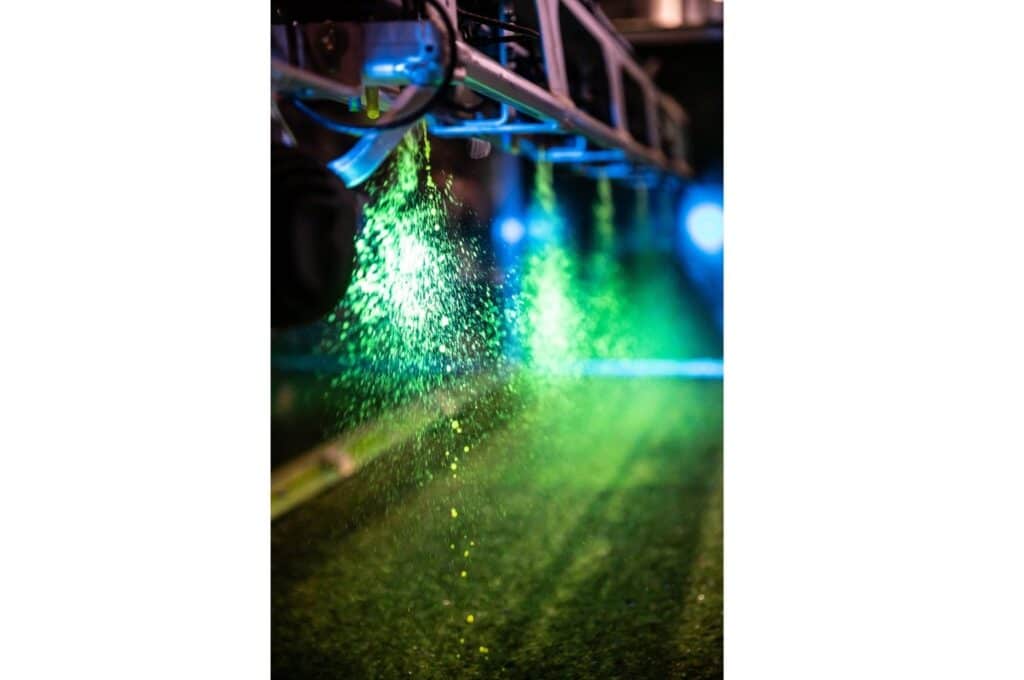As 3D printing is increasingly being used wherever milling or casting were previously dominant, additive manufacturing is currently revolutionizing mechanical and production engineering. The “Systems & Components” area at the upcoming Agritechnica tradeshow this coming March in Hanover Germany, will be presenting itself as the driving force behind tool-free manufacturing.
The B2B platform for the entire off-highway sector’s supplier industry will be taking place as part of Agritechnica for the fifth time. How the new technologies can be integrated into your own business model and how your product portfolio can be extended with 3D printing are just two of the aspects on the agenda in Hanover.
What sounded completely futuristic just a few years ago has long since become a key technology within the off-highway industry: additive manufacturing. While 3D printing processes were too time-consuming and costly to be used in manufacturing vehicle components for some time, all major construction and agricultural machinery manufacturers, including Caterpillar, John Deere and Komatsu, are working to make the technology fit for industrial volume production. Firstly, they are still using the process for rapid model and tool manufacturing. 3D-printed sand cores remain essential for high-quality cast iron leading to components such as axle housings or wheel hubs. Secondly, the companies have included the first directly printed components in their supply chains. This enables them to produce highly-complex components quickly and in extremely small quantities while ensuring maximum possible flexibility and cost effectiveness.

Spare parts supply rethought
In three-dimensional printing, a component is built up layer-by-layer based on digital design data. The material is only applied wherever it is needed, thus enabling the realization of naturally inspired bionic geometries that are difficult or impossible to manufacture using subtractive methods such as milling, lathing or casting. This makes the manufacturing technique particularly interesting for those sectors that are reliant on lightweight components. Consequently, the design engineers’ objective is to use these new design freedoms to optimize the functions of components that are fitted in mobile working machines.
In achieving this, additive manufacturing is increasingly meeting the demand for just-in-time spare part production and the customization of these parts – without the use of tools, in the required quantity and without minimum purchasing volumes. Since the spare and retrofit parts can also be easily reprinted and supplied after a long period of time based on the stored CAD data, there is no longer any need for resource-intensive warehouse logistics. Maintenance and spare part management can be carried out proactively and economically. This results in interesting after-sales service perspectives, some of which have already been transformed into reality today. For instance, the machine manufacturer can determine the status of the engine based on sensor data and manufacture the required spare part on-demand even before a failure occurs on the field or the construction site in the first place – entirely in keeping with predictive maintenance. This therefore makes low-cost predictive maintenance possible even for special parts.
New materials with new characteristics
While it was particularly plastic components that were initially printed layer-by-layer, 3D metal printing has also since progressed beyond the trial stage. The high strength of new materials enables the production of weight-efficient, load-bearing components using aluminium or steel. The corrosion-resistant parts manufactured from these are ideal for long-term use and withstand the harsh conditions in the off-highway sector. Conceivable possible uses for Selective Laser Melting (SLM) or Selective Laser Sintering (SLS) include precisely manufactured metal parts in the drive train, for instance, but also in the engine itself as well as in cooling units, transmissions, axles or chassis.
For some time now, the familiar powdered materials have been extended with innovative metal filaments that are suitable for manufacturing stainless steel components by means of ‘Fused Filament Fabrication’ (FFF). The filament used in this process consists of a metal powder and a plastic mixture that melts at 150 to 200 degrees Celsius. After the debinding and sintering process, the object can be welded, polished or coated as in the case of conventional stainless steel. The components manufactured in this way are still comparatively small and are produced in low quantities. However, the increasing extension of molten layer processes to metals promises the flexible production of individual parts up to and including small series.

The best of two worlds combined
However, the technologies always encounter their limits when conventional methods can be used to produce high quantities cost-effectively. Many activities are therefore focusing on hybrid processes that enable additive manufacturing to be integrated on CNC machines. The objective is to overcome the boundaries of additive methods and enable them to be used where it has so far proved impossible to implement them.
The intelligent combination of 3D printing with techniques such as machining, sintering or injection moulding is intended to provide access to new approaches – an intention that was also pursued by the ‘KitkAdd’ project, in which scientists from Paderborn University undertook research together with the Karlsruhe Institute of Technology (KIT) and industrial companies. As part of a feasibility study, John Deere analysed the production of planetary gear transmissions with improved lubricant supply as well as heat exchangers for decentralised fuel cooling. After a period of just over three years, the project was brought to a successful conclusion in March 2020. Industrial production concepts that enable more cost-effective manufacturing compared to the purely additive process chain were established for the components.
Digital twin meets rapid prototyping
To be able to exploit the full potentials of additive manufacturing, the components are developed using the latest design engineering methods. The biggest challenges involved in manufacturing low-distortion components are adherence to the required tolerances and dimensional accuracy. The digital twin concept helps to identify problem areas in additively manufactured components, avoid scrap and respond flexibly to design changes. It is made possible by simulating the real-life manufacturing situation on a computer.
The Kaiserslautern-based Fraunhofer Institute for Industrial Mathematics ITWM goes one step further. Using ‘hardware-in-the-loop’, it enables entire mobile working machines to be simulated and virtually tested in a software program. The test bench enables manufacturers to test, improve and optimise practical suitability and performance at an early stage of development. “We are able to test all kinds of construction machines such as different types of cranes, for example”, explains project manager Dr Christian Salzig. All functional and stress tests can be carried out during the concept phase, not only once a prototype has been built. The tests show design engineers the inclination angle as of which the crane’s digital twin becomes unstable or tips over. Technical malfunctions can also be simulated – e.g. what happens if a cable breaks at a joint or the lifting element’s hydraulic system loses pressure. Salzig also points out another aspect: “With each new generation, the manufacturers naturally want to save material, reduce energy consumption, integrate new functions and make the machines smaller and more mobile.” These are precisely the kinds of improvement that hardware-in-the-loop makes possible. During the simulation, the Fraunhofer experts determine whether the desired characteristic can be achieved using less material or whether the same performance would also be achievable using a machine with smaller dimensions.
The future of manufacturing is 3D
Looking ahead to Systems & Components 2022, it can be seen that demand for additively manufactured components for mobile working machines is growing – and therefore also the market for corresponding printing materials, machines, software and services. Exhibitors will be demonstrating where 3D printing can bring its strengths to bear in full in the off-highway sector and which new applications it is enabling for after-sales service at the Agritechnica trade fair grounds in Hanover from 27 February to 5 March 2022. The topic will not only play a central role in the exhibitors’ presentations, but also in the ‘Future Lounge’ – the Systems & Components expert forum in which the future scenarios for additive manufacturing will be discussed.

![RightSpot Ad Template Digital-1400×190-px[76] Ag Leader RightSpot](https://world-agritech.com/wp-content/uploads/elementor/thumbs/RightSpot-Ad-Template-Digital-1400x190-px76-r316mmc0hgoob9qxmklllnnbxta1nlj7t2vjkoyeek.png)









